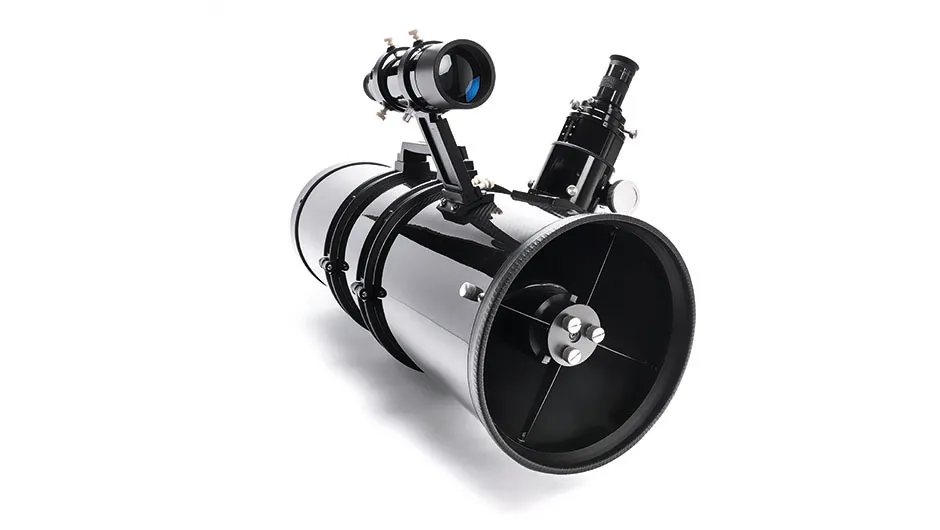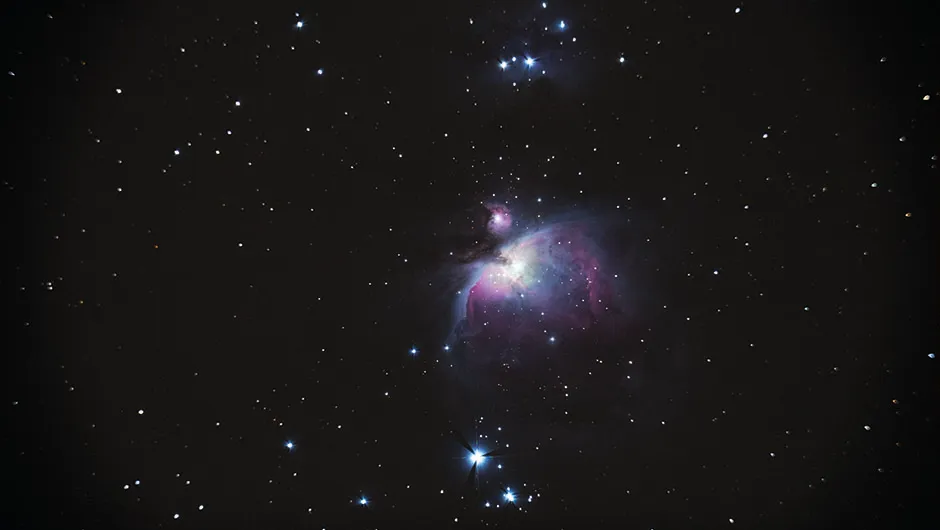Price: £849.00
Focal Length: 800mm (f/3.8)
Weight: 6.75kg
Supplier: Telescope House
Telephone: 01342 837098
Website: www.telescopehouse.com
The Mk II is a fast Newtonian reflector with a 210mm parabolic primary mirror working at f/3.8.
Although designed with astrophotography in mind, it can be used for visual observing too.
A view of the M42 region in Orion’s Sword using a 20mm eyepiece (40x magnification) revealed sharp stars in and around the main nebula.
All four of the Trapezium Cluster’s main stars could be clearly seen, shining like bright jewels.
Plenty of tenuous nebulosity was visible around the outskirts of the nebula too, giving a very pleasing view.
The optimisations for astrophotography include an oversized secondary mirror with an 85mm minor axis, to allow full illumination of large photographic sensors, and a construction that uses low-expansion materials to reduce focus issues caused by temperature changes.
The Mk I’s excellent portability carries through to the Mk II.
The scope is light, making it easy to transport and lift onto a mount. Both tasks are made easier thanks to a carry handle on its tube rings.
A universal 44mm dovetail is supplied and is compatible with Synta/Vixen mount clamps.
The main tube is made from carbon-fibre, a material that’s light, strong and thermally stable.
The primary and secondary mirrors also share low thermal-expansion properties.
This telescope is among our pick of the best telescopes for astrophotography

Accuracy and adjustment
As this is a Newtonian telescope it will show coma towards the edge of the field.
This manifests as tiny, comet-like tails attached to stars, pointing away from the centre of the field of view.
Coma can largely be corrected by fitting a matching field-flattener, although this can be a relatively expensive add-on relative to the cost of a scope.
Accurate collimation is important for a fast-imaging Newtonian such as this.
The PN210 Mk II’s updated and simplified secondary collimation system consists of three thumbscrews.
These are quick and easy to adjust, which is helpful as regular adjustment seems necessary. A gentle touch is also required to get the best results.
The primary cell has also been redesigned and offers three large spring-loaded adjustment knobs, each paired with a locking screw.
In use, this arrangement felt a little imprecise. Although we could get to what looked like perfect collimation, even gentle application of the locking screws could mess this up.
Our best and most precise results were obtained by collimating on the fly before each session.
Fortunately, the large adjustment knobs on both primary and secondary mirrors made this a fairly easy task.

Finding focus
While image testing, as well as the expected diffraction spikes from the scope’s four-vane spider, other diffraction effects appeared too.
Bright stars were surrounded by ‘light-sectors’ interrupted at 120 intervals by ‘shadows’, presumably caused by the three sturdy clips retaining the primary mirror.
The PN210 Mk II uses a 2.5-inch Hexafoc Deluxe focuser with a larger than usual opening to reduce vignetting effects.
The focuser also offers a 10:1 speed-reduction knob to help you achieve final, accurate focus.
The main body of the focuser feels robust and can be adjusted in terms of focuser tension.
But once focus has been achieved, there’s no facility to rotate an attached camera.
There are thumb and grub screws near the focuser base but no mention in the instructions as to what they’re for.
Speaking of instructions, we were disappointed to see that those supplied with the PN210 Mk II were for the Mk I model.
The PN210 Mk II is a portable grab and go scope. Its fast, f/3.8 optics allow you to go deep with relatively short exposures.
But it still feels tricky to get and hold collimation – an essential element to a fast Newtonian.
There’s also the question of whether a field-flattener should have been included, given that it is a photographic Newtonian; without one, there’s coma visible and an interrupted radial diffraction pattern around bright stars.
Great shots are possible with patience – but it takes a bit of careful tweaking to get the best results.

Fast light collection
The 210mm parabolic primary mirror at the heart of the PN210 Mk II works at f/3.8.
This is considered a fast focal ratio, a photographic term that essentially describes how quickly a certain depth of image can be delivered.
One major benefit of a fast system is that exposure times can be kept relatively short.
This also goes hand-in-hand with the excellent portability of the telescope.
Transport it to a dark-sky location and even with moderately accurate polar alignment, it should be possible to take relatively short but still quite deep exposures.
The 800mm focal length of the primary mirror delivers a fairly wide field of view at prime focus.
Using a Canon EOS 6D, a full frame DSLR, our images covered a sky area 2.5x1.5°.
Consequently, the fast, wide-field delivery of the PN210’s optics makes it best suited for the imaging of extended deep-sky objects.
Being a Newtonian reflector, the PN210’s field does suffer from coma, which becomes very noticeable towards the edge of frame, especially when using a camera with a large sensor.
A matching field flattener is recommended to reduce this issue.
Carbon-fibre tube and rings
The PN210 Mk II has a strong carbon-fibre tube.
As well as being light, easy to carry and easy to mount, the tube has low thermal-expansion properties.
This helps maintain focus throughout temperature changes that occur at night.
The matching tube rings have a convenient carry handle, which aids portability.
Focuser
The PN210 Mk II is fitted with a 2.5-inch Hexafoc DeLuxe focuser.
This accepts 2-inch equipment or 1.25-inch barrels via a supplied adaptor.
The focuser’s internal diameter is overly large to avoid vignetting.
A 10:1 speed-reduction knob allows you to attain an accurate final focus position.
The focuser cannot be rotated.
Finder
The unsung hero of many telescope setups is the finder and a good one is essential for a positive experience.
The 8x50 finder supplied has an illuminated reticule to make precise pointing even easier.
The finder is held by two rings each fitted with three screws, one set being adjustable.
Secondary mirror and collimation
An oversized, 85mm minor-axis secondary mirror ensures that large sensors are fully illuminated.
The mirror is made of borosilicate glass, which has low thermal-expansion properties.
Secondary collimation has been simplified for the Mk II and now consists of three thumbscrew adjustments – simple, but effective and stable.
Primary mirror and collimation
The PN210 Mk II uses a 210mm parabolic primary mirror made from low-expansion borosilicate glass.
Low thermal expansion means the mirror is better at maintaining its optical figure during changes in the outside temperature.
The primary is held securely in a cell, collimated by three hand-adjustable knobs, each paired with a locking screw.
This review originally appeared in the January 2018 issue of BBC Sky at Night Magazine

